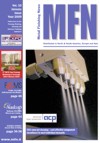E-Archive
MFN Trainer Column
in Vol. 10 - January Issue - Year 2009
Maintaining our Standards

Paul Huyton
This column is a regular feature and is written by one of our MFN trainers or the Editorial Office. Readers are invited to send comments or questions to info@mfn.li. For more information about the trainers, see our website www.mfn.li/trainers.
Two core principles in technical training are to provide an awareness of Technical Standards and to develop a capability to understand the requirements laid-out in these standards. So here at MFN we have decided to establish a Standards Forum so that the developments and changes in relevant standards can be discussed by our readers. I am pleased to announce that I have accepted the role of co-ordinating data collection, analysis and dissemination of any significant developments in these standards.
In this endeavour I will be aided by the MFN family, the global team that collectively have immense breadth of experience and depth of knowledge in metal finishing. And I am issuing an open invitation to all readers of MFN to contribute to this quest to “keep ahead of the curve” in technical standards.
The MFN readership constitutes an authoritative resource and individual readers will have unique insight to a particular aspect of the standards they encounter. So I invite every individual who wishes to share their insight to contact me at paul@mfn.li so that I can edit, co-ordinate and disseminate the information.
The information that I am expecting to handle can be categorized as follows:
New Standards: with emerging technology it may be necessary for completely new standards to be issued.
Revised Standards: existing standards are often amended to clarify or enhance the requirements or process quality control (see ISO 9001:2008, below).
Industry Standards: Internationally recognized standards such as the Aerospace Material Standards (AMS) from the SAE.
Proprietary Standards: First and second tier companies often produce standards which, subject to their approval, can be explored in our articles.
Queries on standards: these can be addressed to me at paul@mfn.li.
Validation of requirements: Representatives from the organizations issuing the standards are invited to expend upon their requirements.
Comparison of requirements: By comparing requirements in various standards the quality control of the process can be explored and optimized.
Audit requirements and experiences: The implementation and efficacy of a standard is validated by audit. Sharing audit experiences would be a valuable contribution to our collective understanding of the requirements.
ISO 9001:2008
Many of you will be aware that this new revision of the ISO standard was released 15 November 2008. Some useful information regarding this revision is as follows:
New Requirements: The good news is that there are NO new requirements; this revision is to clarify and strengthen existing requirements.
Export requirements: An exporter must evidence that they have established the statutory and regulatory requirements for their product in the country to which they are exporting. Although this appears to be a commercial matter it is relevant to the Review of Product Requirements within the Quality Management System.
Control of External Documents: The company must evidence that they review and control external documents which are necessary for the planning and operation of the quality management system. This clarifies which documents need to be controlled.
Management Representative: A quality consultant may be used for internal audits or even as the Quality Manager, but the nominated Management Representative must be a member of the management team. This is to embed quality management awareness in the company culture.
Competence: It is necessary to establish the required competence for any position in the company and ensure that competence is assessed. Just having a record of training is a poor response. As with the MFN training courses a test with an established pass mark is a valid test of competence.
Information systems: these are a “support service” and as such are subject to audit requirements.
Work environment: Any environmental condition that could affect quality is subject to audit. These considerations are not limited to the examples given within the standard.
Work done under warranty: Any work undertaken under warranty is to be controlled as with the original work. As such it must be reviewed & validated according to the standard.
Health, Safety & Environmental Issues: Even though these are subject to control under other ISO Standards, Health &Safety and Environmental issues that affect Quality can be audited under the ISO 9001:2008 standard.
Implementation dates: The standard is now “live” and companies may be accredited by a surveillance or re-certification visit. Companies can remain with ISO 9001:2000 but this certification will no longer be valid after November 2010.
Conclusion
Training is a sharing of knowledge that can lead to development, innovation and progress. I hope that you will feel free to contribute to the MFN Standards Forum for our mutual benefit and the advancement of our industry.
Best Regards
Paul Huyton, paul@mfn.li




























